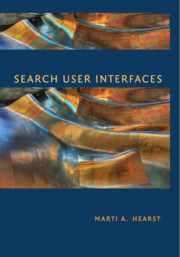Book contents
- Frontmatter
- Contents
- Preface
- 1 The Design of Search User Interfaces
- 2 The Evaluation of Search User Interfaces
- 3 Models of the Information Seeking Process
- 4 Query Specification
- 5 Presentation of Search Results
- 6 Query Reformulation
- 7 Supporting the Search Process
- 8 Integrating Navigation with Search
- 9 Personalization in Search
- 10 Information Visualization for Search Interfaces
- 11 Information Visualization for Text Analysis
- 12 Emerging Trends in Search Interfaces
- Appendix: Additional Copyright Notices
- Bibliography
- Index
- Author Index
- Plate section
4 - Query Specification
Published online by Cambridge University Press: 05 March 2013
- Frontmatter
- Contents
- Preface
- 1 The Design of Search User Interfaces
- 2 The Evaluation of Search User Interfaces
- 3 Models of the Information Seeking Process
- 4 Query Specification
- 5 Presentation of Search Results
- 6 Query Reformulation
- 7 Supporting the Search Process
- 8 Integrating Navigation with Search
- 9 Personalization in Search
- 10 Information Visualization for Search Interfaces
- 11 Information Visualization for Text Analysis
- 12 Emerging Trends in Search Interfaces
- Appendix: Additional Copyright Notices
- Bibliography
- Index
- Author Index
- Plate section
Summary
In the query specification part of the information access process, the searcher expresses an information need by converting their internalized, abstract concepts into language, and then converting that expression of language into a query format that the search system can make use of. This chapter discusses the mechanisms by which information needs are expressed. The two main dimensions for the query specification process are:
(1) The kind of information the searcher supplies. Query specification input spans a spectrum from full natural language sentences, to keywords and key phrases, to syntax-heavy command language-based queries.
(2) The interface mechanism the user interacts with to supply this information. These include command line interfaces, graphical entry form based interfaces, and interfaces for navigating links.
Each is discussed in the sections below.
Textual Query Specification
Queries over collections of textual information usually take on a textual form (querying against multimedia is discussed in Chapter 12). The next subsections discuss different kinds of textual input for query specification.
Search Over Surrogates vs. Full Text
In older bibliographic search systems, users could only search over metadata that hinted at the underlying contents. To look for a book on a topic in an online library catalog, the searcher was restricted to the text in the title or the few subject labels that the librarian who had catalogued the book had used to describe it (Borgman 1996). A book that mentions an interesting idea, but only in a secondary manner, would most likely not be indexed with that term (Cousins 1992).
- Type
- Chapter
- Information
- Search User Interfaces , pp. 91 - 119Publisher: Cambridge University PressPrint publication year: 2009
- 1
- Cited by



